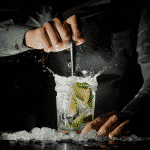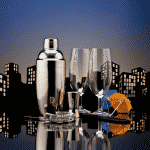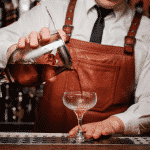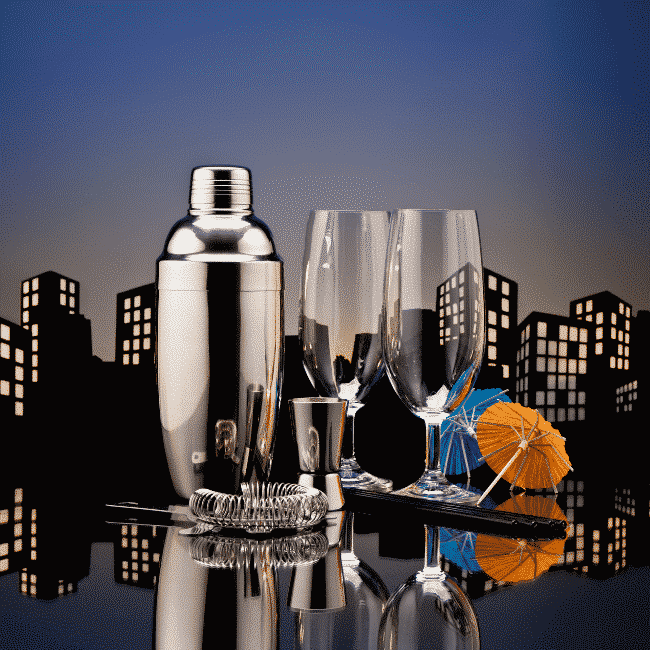Bar Equipment
To novice bartenders bar equipment and terminology can be confusing, however it will soon become like an extension of your arms and hands!! Bartenders should become confident handling all bar equipment as quickly as possible. The more confident you are with the equipment used behind the bar, the quicker you will be able to make drinks and the more professional you appear to the customer. Even the simplest thumb roll or spin of a tin gives the impression of confidence and professionalism to all customers at the bar.
Boston Glass
The Boston Glass is used in making 99% of all cocktails. It is used for shaking, stirring, passing and chilling the cocktails you make. It is essentially a toughened 16oz glass (American Pint) glass. Although these glasses are toughened they take a constant battering every shift so care needs to be taken over them. Glass is put under stress when its temperature changes very quickly; therefore cold water should always be used when rinsing out Boston glasses after use to keep the temperature as consistent as possible. Hot water should only be used to rinse a Boston glass after it has been used to make a cocktail containing milk/cream/coconut or a Bloody Mary as these products need the higher temperature to clean the glass effectively.
Always use Boston glasses to shake cocktails – never rocks or Collins glasses!!! Always place the Boston glass in front of the customer and pour the cocktail ingredients into the Boston glass, not the tin. There are two reasons for this – the customer can see exactly what’s going into their drink, and you as the bartender can judge if you have the correct volume of liquid in the Boston to fill the glass in which the cocktail will finally be poured. Ice should always be added as the final ingredient to the Boston glass as if it is added first it will instantly begin to melt therefore dramatically changing the quality of the final product.
When using the Boston glass to create a stirred drink (Manhattan/Martini/Negroni) the glass should always be held at the base, never in the middle. The reason for this is to prevent any unwanted heat transfer from your hands creating unwanted dilution.
Boston Tin
The Boston tin is the female to the Boston glass (the glass goes inside the tin… geddit?!?). The Boston tin should be placed on top of the glass and a firm tap used to form a seal between the two. They can then be snatched back off the bar top and shaking can commence (always be sure you have a good seal as this can go horribly wrong if the seal is not strong!!). Always place the Boston glass on the bar top (off the peanut rail) BEFORE making the seal between the two.
Use the guidelines above for cleaning the Boston tin. Check your Boston tins & glasses throughout the shift by smelling them as if they are dirty in any way this will have a detrimental effect on the rest of your cocktails for the evening. If the set smells bad even after rinsing add a small amount of lemon juice, a lemon wedge and water and shake with ice as if making a cocktail.
Flat Top Barspoon
The flat top barspoon has many uses on the bar. It can be used for stirring, smuddling and layering cocktails. To stir place the spoon end in the Boston glass and rotate passing between your fingers. Smuddling is a cross between muddling and stirring. It is used in Mojitos & Mint Juleps mainly, and involves drawing a vertical rectangle to ensure the ingredients are spread equally throughout the cocktail. Finally to layer liquids on top of another pour the liquid down the bar spoon with the flat end touching the top of the liquid in the glass. The spiral of the spoon will slow the flow & allow distinct layers of liquids appear in the glass.
Hawthorn Strainer
The hawthorn strainer is used in conjunction with the Boston tin only. Using it with other equipment, such as the Boston glass or other glassware will not allow a good strain.
The hawthorn strainer should be placed on top of the Boston tin with the spring in the tin and ‘ears’ over the edge of the tin. Pour the liquid between the two ears of the strainer into the glass required. There is a small lip on the hawthorn strainer which when pushed closes the gap between the spring spirals and allows less chards of ice from the tin into the glass. Always try to minimise the amount of ice allowed from the tin into the glass without allowing the liquid to spill out from either side of the ears.
Cocktails should always be strained – never empty the contents of the tin straight into the glass (known as dirty ice), with the exception when making a Caipirinha or your manager allows it.
Julep Strainer
The julep strainer is used when straining stirred drinks, such as Manhattans, Martinis and Negronis from the Boston glass into the glass. Used in a similar way to the hawthorn strainer it is placed over the ice in the glass and held with a finger to prevent any ice falling out of the Boston into the customers’ glass. When straining into a Martini glass ensure liquid is poured slowly down the side of the glass to prevent any unsightly bubbles forming in the cocktail.
Fine/Tea Strainer
The fine strainer is used in conjunction with the hawthorn strainer when pouring from a Boston tin into a Martini glass. The fine strainer removes any small shards of ice which may slip through the hawthorn strainer to provide a super clean & smooth cocktail for the customer.













Pingback: The Perfect Daiquiri | Be A Better Bartender